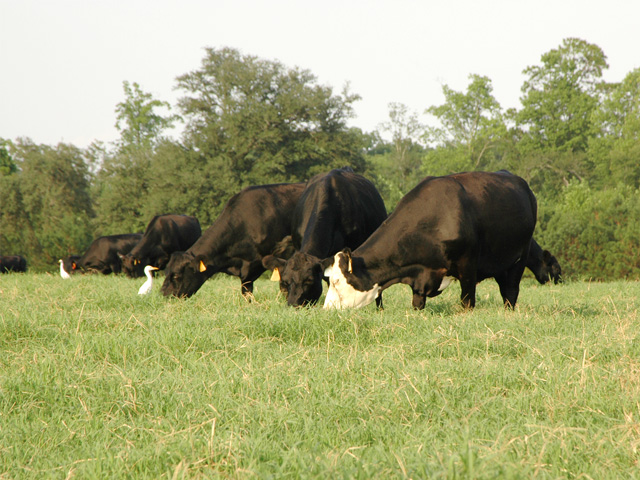Winter Grazing
Bermuda is a Good Foundation for Stockpiling
Extending grazing with bermuda is a viable option for many cattle producers this year, reports James Rogers, associate professor with the Noble Research Institute. He notes it's not too early to plan for fall and winter feeding for the herd.
It's important to differentiate between feeding and grazing when it comes to maintenance of the cow herd. Feed and hay add costs to the operation, says Rogers. But extending grazing can help reduce costs. A recent study at Noble evaluated forage systems used to reduce winter feeding, where Rogers says researchers looked at known practices used to extend grazing seasons such as bermudagrass stockpiling and interseeding winter annuals into bermudagrass. They combined those approaches into one system (SPINT) and compared it to a control where bermudagrass was fertilized in the spring, and hay and range cubes were fed through the fall and winter as pastures ran short.
On the SPINT system, where bermudagrass was interseeded with wheat, nitrogen was added at a rate of 50 to 60 pounds per acre to help accumulate stockpiles. The higher rates were in the interseeded wheat. This system resulted in more forage mass throughout the winter. An economic analysis of the results is underway.
A simple way to help producers determine if the SPINT system is something they might consider has been worked out by the Noble researchers. Rogers says it boils down to the answers to 7 questions. Consider the following:
P[L1] D[0x0] M[300x250] OOP[F] ADUNIT[] T[]
1. Do you have an appropriate stocking rate? If you are overstocked, you may still need to feed hay to fill forage gaps.
2. Do you have soil deficiencies that might limit a response to fertilizer applications? To answer this you need to soil test in areas intended for stockpiling and/or interseeding.
3. Do you have an area that is appropriate for stockpiling forage or interseeding? The area should be fenced, well-drained and have a water source. A rule of thumb for area needed is 1 acre per cow for stockpile, and 1 acre per cow for interseed.
4. Do you have a good, solid stand of bermudagrass that can hold up cattle during wet periods? If not, delay implementing the system for one year to allow stand density to increase, or go to a different area.
5. Do you have the equipment you need to interseed? A no-till drill and tractor are things you'll have to have to interseed. If that equipment isn't available you can still stockpile. You may even consider adding annual ryegrass to the bermudagrass which can be established by broadcast seeding.
6. Do you have a back-up plan? Weather is always unpredictable, so it's important to have a backup plan in terms of feed or hay on hand, or readily available.
7. Are you willing to experiment? If you're doubtful about this, take a season and observe others who are making this work. Ask questions and do your research. Every operation is unique, so it's important ultimately to develop a system that works best on your land.
(c) Copyright 2020 DTN, LLC. All rights reserved.






